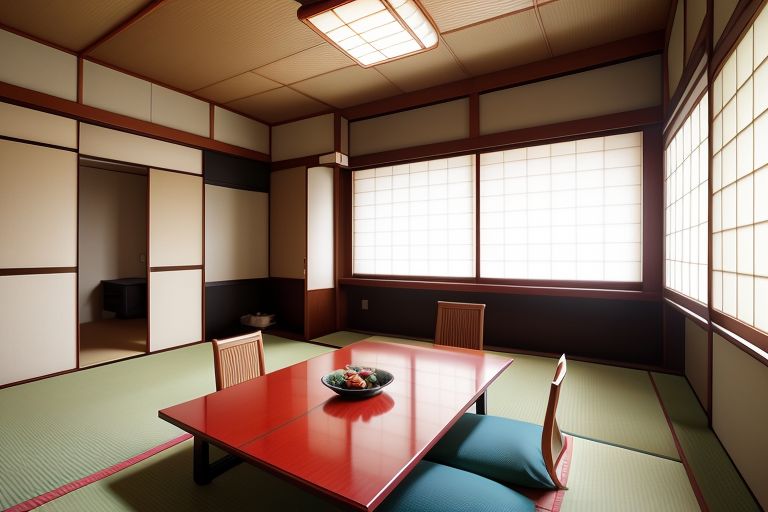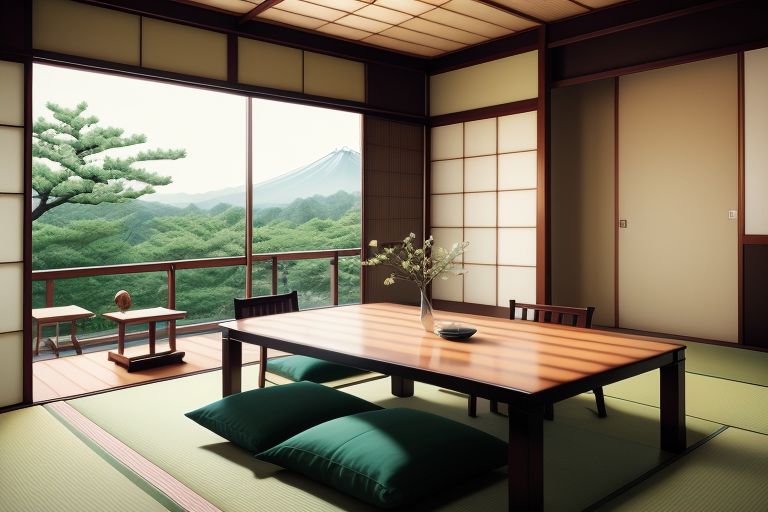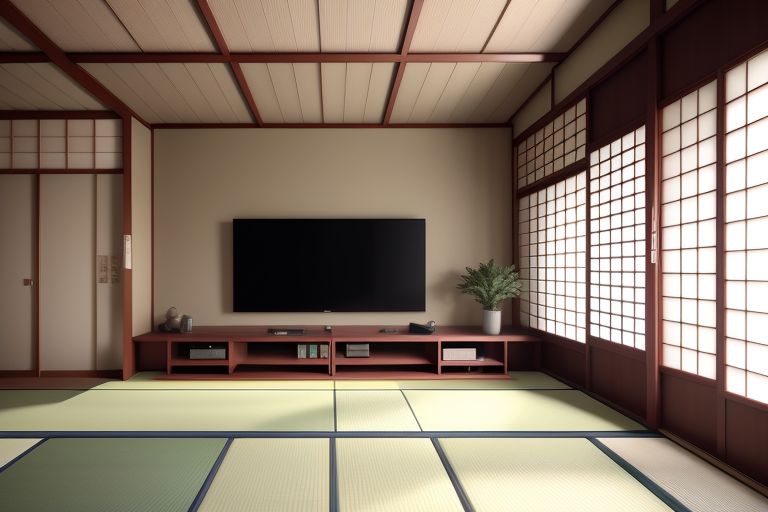Japanese Interior Design
Japanese interior design ravishes designers and prospective homeowners all over the world with its enduring beauty and philosophical ambiance. Inspired by the philosophy of Zen Buddhism, Japanese interior design pays attention to maintaining the idea of state minimalism and the friendly relationship of people with nature, as well as efficient use of space. This piece will further investigate the secrets of Japanese interior design through its origin, important features, and Japanese-inspired interior ideas that are a recent trend.

Japanese Interior Design
Japanese interior design is an embodiment of the nation’s culture, and it holds the history of many years, especially the concept of “Wabi-Sabi,” which aims to highlight the beauty in everything imperfect, impermanent, and the natural aging process. This principle of natural beauty in architecture, art, and interior design has affected them since ages ago and was then achieved by combining beauty with functionality to make a specific style that gives a harmony of looks and usage.
Japanese interior style centers on essentialism.
The soul of Japanese interior design lies in the philosophy of seeking the minimum and simplicity. Since we unwind, crowded places provide us with a space of peace and focus, which makes us soulful and conscious of the needs and reasons of our lives. The application of natural materials like wood, stone, and paper not only manifests the deep interpersonal relationship with nature but also arouses comfort and fuzzy feelings.
Main Factors Worldwide Presented by the Japanese Interior Design
Natural Materials
Traditionally, the Japanese interior has a strong focus on the usage of native materials found in the country, including wood, bamboo, paper, and stone. They are treasured for their classical beauty, rough and warm surface, and aging beauty. Possibly the most recognizable attribute is wood, which is often utilized for floorboards, ceilings, and more. On the other hand, shoji screens and lighting fixtures made of paper and bamboo are common.
Sliding doors and screens
Shoji are wooden screens that have two small openings at the top of the screen and are made from translucent paper. The presence of these screens defines the Japanese culture of interior design. The elements of a screen and sliding doors can be the variables that transform the linear flows of the space into nonlinear movements in it. These screens between the interior and exterior emphasize the interaction and gradual infusion of natural light through which the whole atmosphere of meditation and serenity is harnessed.
Neutral Color Palette
The Japanese interior design style only uses natural colors like beige, brown, and gray, which have less intense contrast combinations and can be calming and soothing at the same time. They remove these muted tones that will create a sense of coziness and balance, an effect that helps to make natural materials and textures stand out. A heavy use of bold colors with navy, forest green, or rich reds is done deliberately, most of the time just based on natural phenomena or collections seen in nature.
Integration of Nature
Japanese interior design, which is foremost linked to nature, is another important gym. This can be expressed not only by the purposeful location of greenery, water features, and natural objects such as stones or bonsai trees but also by other art arrangements in a way that manages the space and traffic patterns. Big openings created through large windows or glass doors offer visual contact with the outside world, which never separates inside from outside life.
Set Out for Space
In contrast to the minimalistic Western style, Japanese interior design largely focuses on smart space usage, which means that this style includes both functionality and freedom of movement. The concept of “ma, “the integration of space consciously, is intensive, obtaining the practical integration between space and solid mass and promoting a peaceful and contemplative feeling.
Inspired Ideas for How to Add Japanese Interior Design Elements
Incorporate natural materials.
Take on using natural materials like wood, stone, and bamboo in interior design. Perhaps you should work with wooden flooring or put wooden beams or wooden panels in your walls or the utility of your ceiling. Spice up with the help of bamboo features such as blinds, furniture, or decorative bamboo for additional coordination and a decorative look.
Convert structures into open spaces by laminae partitions.
Introduce shoji screens into your household and provide the space with flexibility, thereby creating adaptability. More than their purpose to provide privacy, the sliding doors and screens also enable a soft passage of daylight, resulting in a tranquil and peaceful buildup.
Support the calmness by lighting with neutral coloring.
Choose a chalk-beige color palette that is inspired by nature, just as it is with gray and brown tones. Your space will look alive and warm. Such a restrained palette relaxes and mirrors the scene, which makes the nature-themed elements pop out of the scene. Use a mix of bold colors sparingly, as they remind you of nature in your decorating. They could be in subtle tones.
Bring nature indoors.
Harmonize different types of nature to decorate the interior design, which could be done by placing some potted plants, bonsai trees, or small water features like fountains or ponds into the interior decoration. Furthermore, artificial lights should be substituted with nature’s gift of natural lights by making the windows and doors large so that it is possible to provide visual connections to the outdoors.
Coming along with simplicity and minimalism Target the phrase.

Embrace the virtues of conciseness and being dominated by only important things by getting rid of things that fill your living spaces and by keeping only useful elements. Choose light and easy forms to furnish and decorate your space, and make it as clean and peaceful as possible. Ensure that it isn’t packed with items.
Develop deliberate negative space.
So go by building up an idea of “ma” to create negative spaces that are empty in your interior. Such pauses in the usage of a relatively more visually active medium encourage attaining the feeling of balance, peacefulness, and meditation so that the eyes do not need to search for something and can just enjoy the beauty of simplicity.
Highlight the native or folk tales of Japan.
By introducing traditional Japanese components to your interior design, i.e., tatami mats, fusuma sliding doors, and tokonoma alcoves, you can successfully create the desired effect. These features are not only American but also become symbols of the cultural heritage and craftsmanship of Japanese objects of design.
Conclusions about Japanese Interior Design
The Japanese art of interior design is ageless, and by emphasizing simplicity, harmony with nature, and smart usage of space, it proves itself to be the most classical. The use of intentional and small details such as natural material, sliding doors and screens, a neutral color scheme, and wise use of spaces can set the stage for a calm and meditative type of living wherein the mind is clean and peaceful through the practice of mindfulness. That was all about Japanese Interior Design.

A “wabi-sabi” way of thinking will help you wonderfully combine old with new and then grow to the strength of an aged piece with the natural aging marks in your design choices. Whether your design embodies a traditional Japanese look or you pick out those pieces that you find congenial, what the Japanese decorating style provides you is a methodology for creating a relationship between humans and their dwelling place that results in a feeling of comfort.
FAQs about Japanese Interior Design
Basics of Japanese interior design: what are the main components?
Some of the vital components are nature-based materials like wood, bamboo, and stone; sliding doors and screens (shoji); keeping the color palette of the neutral tones close to the earth; having nature present by inserting plants and water features; and intentionally using space and space smooth characters (ma).
How is it possible to conduct a mix of traditional Japanese design resistance in the interior?
Include local materials, such as wood floors and bamboo accents; utilize paper shoji screens as a room divider; opt for a neutral color scheme; introduce plants and add water features; go for minimal design and declutter; and create design elements that balance out the space.
Will the Japanese design, which I am passionate about, blend with other styles?
Absolutely. An interesting approach to interior design is how Japanese interiors are combined with other styles like modern design, Scandinavian design, or rustic design, which lets the rooms have many more decorations. Simplicity is the main style element. Monochromatic and natural colors and materials are important here. But the most crucial is the harmonic connection to nature.
Apart from this, what are some Japanese traditional items that I can still use as my motif?
For example, the fusion of approaches like tatami mats, fusuma sliding doors, tokonoma alcoves, low-placed seats, and shoji lamps Elements of real Japanese can be used in interior design.
Where does acceptance of or incorporation of the idea of “wabi-sabi” into my living space come from?
Allow nature to take the lead and perfection to step aside by deliberately implementing rustic or slightly imperfect components, including aged wood, handcrafted pots, or asymmetrical arrangements. And opt for natural finishes that are not so extremely polished; hence, they develop character more quickly.
What is Japan’s approximate space for small families with children?
The requirement for a simple style and makeup may look difficult to the children; however, the principle of Japanese design may still be used. Provide movable structures and environment elements made of long-lasting natural materials; redistribute working spaces with extendable divisions; and designate specific play areas to create a feeling of full harmony.

